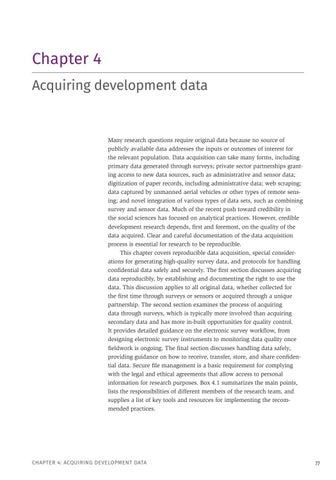Chapter 4 Acquiring development data
Many research questions require original data because no source of publicly available data addresses the inputs or outcomes of interest for the relevant population. Data acquisition can take many forms, including primary data generated through surveys; private sector partnerships granting access to new data sources, such as administrative and sensor data; digitization of paper records, including administrative data; web scraping; data captured by unmanned aerial vehicles or other types of remote sensing; and novel integration of various types of data sets, such as combining survey and sensor data. Much of the recent push toward credibility in the social sciences has focused on analytical practices. However, credible development research depends, first and foremost, on the quality of the data acquired. Clear and careful documentation of the data acquisition process is essential for research to be reproducible. This chapter covers reproducible data acquisition, special considerations for generating high-quality survey data, and protocols for handling confidential data safely and securely. The first section discusses acquiring data reproducibly, by establishing and documenting the right to use the data. This discussion applies to all original data, whether collected for the first time through surveys or sensors or acquired through a unique partnership. The second section examines the process of acquiring data through surveys, which is typically more involved than acquiring secondary data and has more in-built opportunities for quality control. It provides detailed guidance on the electronic survey workflow, from designing electronic survey instruments to monitoring data quality once fieldwork is ongoing. The final section discusses handling data safely, providing guidance on how to receive, transfer, store, and share confidential data. Secure file management is a basic requirement for complying with the legal and ethical agreements that allow access to personal information for research purposes. Box 4.1 summarizes the main points, lists the responsibilities of different members of the research team, and supplies a list of key tools and resources for implementing the recommended practices.
CHAPTER 4: ACQUIRING DEVELOPMENT DATA
77





